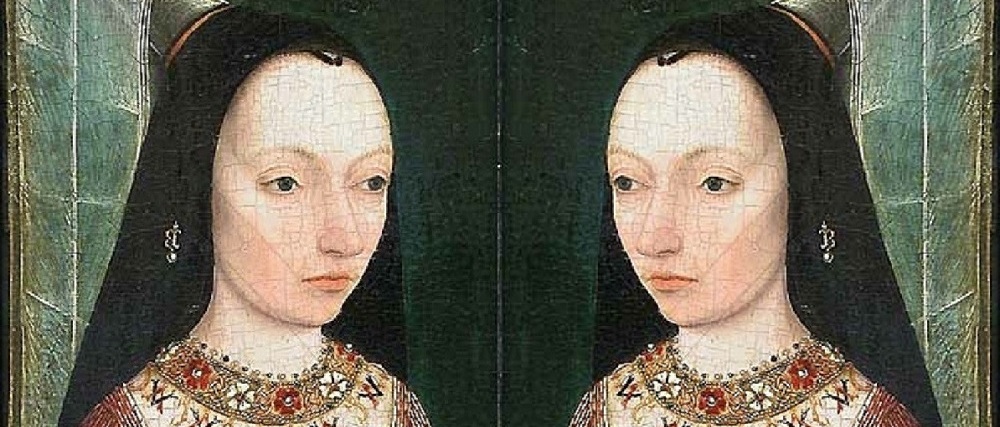Margaret of York, Duchess of Burgundy
Posted on 20th January 2021
Margaret of York was born on 3 May 1446 at Fotheringhay Castle, Northamptonshire, to parents Richard Plantagenet, 3rd Duke of York and Cecily Neville. She was the sister of two English Kings, Edward IV and Richard III.
Margaret was a bargaining chip for her family and when she was about eight years old, negotiations were made to marry her or one of her sisters to Charles the Bold, then Count of Charolais, but these negotiations fizzled out.
Charles went on to marry Isabella of Bourbon in 1454 and they had one child, a daughter, however Isabella died in 1465 and Charles still needed a son.
Margaret was now nineteen years old and still unmarried. Her family were far more powerful than they had been in her youth, her brother was now King Edward IV of England.
Charles sent an envoy to England shortly after his wife’s death, to propose marriage to Margaret, however negotiations would drag on.
Complications arose when Louis XI of France tried everything in his power to break the marriage agreement; England and Burgundy being his greatest enemies. The delay brought others forward for Margaret’s hand in marriage and in 1466 Margaret was betrothed to Peter, Constable of Portugal, however he died on 29 June 1466 before the marriage could take place.
By 1467, Charles the Bold had come to the title of Duke of Burgundy.
Edward IV now needed Charles support against his own domestic problems. Richard Neville. Earl of Warwick was plotting with the French against Edward, and to secure Charles’ support a formal marriage agreement was made in October 1467 and signed in March 1468.
Louis XI continued to try and prevent the marriage, however on the 23 June 1468 Margaret left England and arrived in Sluys, Flanders on 25 June 1468. Margaret first met Charles on 27 June, and they were married on 3 July 1468.
Directly after the marriage, Charles left for Bruges; Margaret entered the city separately to lavish celebrations lasting nine days. Following these celebrations Margaret travelled with her daughter-in-law Mary through Flanders, Brabant and Hainault.
Margaret and Charles spent most of the first three years of their marriage together, but the marriage remained childless. Later due to Charles obsession with extending the Duchy of Burgundy, he was often away in battle and saw little of his wife. For a further three-year period, they did not see each other at all.
Margaret spent her time travelling through Burgundy, representing Charles’ interests and acting as government administrator.
Louis XI had always been an enemy of Burgundy and had fought against Charles and Margaret’s marriage, however in 1474 Charles made a truce with Louis XI and concentrated on campaigning in the Rhineland. By 1476 Charles was unpopular with his people as they were suffering from French embargoes on their products and livelihood, but still Charles campaigned. He suffered terrible defeats and the desertion of his own armies.
To form an alliance, in 1476 Charles arranged the betrothal of his daughter Mary to Maximilian of Hapsburg, but before the marriage could take place Charles died in battle in January 1477 outside Nancy in Lorraine.
It was after Charles’ death that Margaret proved her worth. Her step-daughter Mary was now Duchess of Burgundy, and securing her position and the Duchy from French invasion was now the priority.
Marriage offers started to flood in, but Margaret advised Mary to marry Maximilian of Hapsburg as her father had wished, and the pair married on 18 August 1477. Mary gave birth to a son Philip in 1478 and followed this with the birth of a daughter, Margaret of Austria.
Tragedy was to strike in 1482 when Mary fell from her horse and broke her back. This accident proved fatal and she died on 27 March that year.
Margaret now wanted guardianship of Marys children, but she was to be refused this, with the Burgundian estates taking custody of the children. The Three Estates signed the Treaty of Arras with France, and betrothed the young Margaret of Austria to the Dauphin of France, sending her to be raised in the French court.
In 1489 Maximilian was ordered back to Austria by his father, leaving Margaret and the Burgundian Estates to rule.
Margaret suffered much family tragedy. Her brother George, Duke of Clarence was executed by Edward IV, his own brother in 1478. Edward himself died in 1483, and their younger brother who became Richard III died in battle in 1485. The House of York no longer ruled England, but Margaret continued to meddle and supported anyone who would oppose the House of Lancaster.
Margaret, Dowager Duchess of Burgundy, continued in her duties. She was to see both her step-grandchildren married, and was to care for her step-grandson’s children.
Margaret died on 23 November 1503 aged 57 at Mechelen, Flanders.
Tagged as: Junior Tudors
Share this post:





